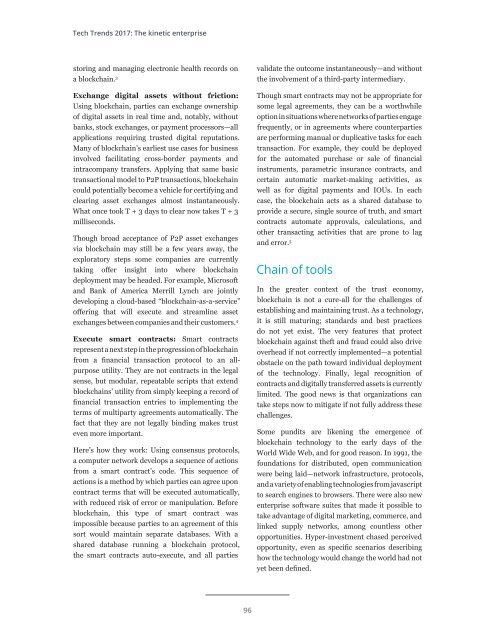Trending the trends Eight years of research
2kcf8xh
2kcf8xh
Create successful ePaper yourself
Turn your PDF publications into a flip-book with our unique Google optimized e-Paper software.
Tech Trends 2017: The kinetic enterprise<br />
storing and managing electronic health records on<br />
a blockchain. 3<br />
Exchange digital assets without friction:<br />
Using blockchain, parties can exchange ownership<br />
<strong>of</strong> digital assets in real time and, notably, without<br />
banks, stock exchanges, or payment processors—all<br />
applications requiring trusted digital reputations.<br />
Many <strong>of</strong> blockchain’s earliest use cases for business<br />
involved facilitating cross-border payments and<br />
intracompany transfers. Applying that same basic<br />
transactional model to P2P transactions, blockchain<br />
could potentially become a vehicle for certifying and<br />
clearing asset exchanges almost instantaneously.<br />
What once took T + 3 days to clear now takes T + 3<br />
milliseconds.<br />
Though broad acceptance <strong>of</strong> P2P asset exchanges<br />
via blockchain may still be a few <strong>years</strong> away, <strong>the</strong><br />
exploratory steps some companies are currently<br />
taking <strong>of</strong>fer insight into where blockchain<br />
deployment may be headed. For example, Micros<strong>of</strong>t<br />
and Bank <strong>of</strong> America Merrill Lynch are jointly<br />
developing a cloud-based “blockchain-as-a-service”<br />
<strong>of</strong>fering that will execute and streamline asset<br />
exchanges between companies and <strong>the</strong>ir customers. 4<br />
Execute smart contracts: Smart contracts<br />
represent a next step in <strong>the</strong> progression <strong>of</strong> blockchain<br />
from a financial transaction protocol to an allpurpose<br />
utility. They are not contracts in <strong>the</strong> legal<br />
sense, but modular, repeatable scripts that extend<br />
blockchains’ utility from simply keeping a record <strong>of</strong><br />
financial transaction entries to implementing <strong>the</strong><br />
terms <strong>of</strong> multiparty agreements automatically. The<br />
fact that <strong>the</strong>y are not legally binding makes trust<br />
even more important.<br />
Here’s how <strong>the</strong>y work: Using consensus protocols,<br />
a computer network develops a sequence <strong>of</strong> actions<br />
from a smart contract’s code. This sequence <strong>of</strong><br />
actions is a method by which parties can agree upon<br />
contract terms that will be executed automatically,<br />
with reduced risk <strong>of</strong> error or manipulation. Before<br />
blockchain, this type <strong>of</strong> smart contract was<br />
impossible because parties to an agreement <strong>of</strong> this<br />
sort would maintain separate databases. With a<br />
shared database running a blockchain protocol,<br />
<strong>the</strong> smart contracts auto-execute, and all parties<br />
validate <strong>the</strong> outcome instantaneously—and without<br />
<strong>the</strong> involvement <strong>of</strong> a third-party intermediary.<br />
Though smart contracts may not be appropriate for<br />
some legal agreements, <strong>the</strong>y can be a worthwhile<br />
option in situations where networks <strong>of</strong> parties engage<br />
frequently, or in agreements where counterparties<br />
are performing manual or duplicative tasks for each<br />
transaction. For example, <strong>the</strong>y could be deployed<br />
for <strong>the</strong> automated purchase or sale <strong>of</strong> financial<br />
instruments, parametric insurance contracts, and<br />
certain automatic market-making activities, as<br />
well as for digital payments and IOUs. In each<br />
case, <strong>the</strong> blockchain acts as a shared database to<br />
provide a secure, single source <strong>of</strong> truth, and smart<br />
contracts automate approvals, calculations, and<br />
o<strong>the</strong>r transacting activities that are prone to lag<br />
and error. 5<br />
Chain <strong>of</strong> tools<br />
In <strong>the</strong> greater context <strong>of</strong> <strong>the</strong> trust economy,<br />
blockchain is not a cure-all for <strong>the</strong> challenges <strong>of</strong><br />
establishing and maintaining trust. As a technology,<br />
it is still maturing; standards and best practices<br />
do not yet exist. The very features that protect<br />
blockchain against <strong>the</strong>ft and fraud could also drive<br />
overhead if not correctly implemented—a potential<br />
obstacle on <strong>the</strong> path toward individual deployment<br />
<strong>of</strong> <strong>the</strong> technology. Finally, legal recognition <strong>of</strong><br />
contracts and digitally transferred assets is currently<br />
limited. The good news is that organizations can<br />
take steps now to mitigate if not fully address <strong>the</strong>se<br />
challenges.<br />
Some pundits are likening <strong>the</strong> emergence <strong>of</strong><br />
blockchain technology to <strong>the</strong> early days <strong>of</strong> <strong>the</strong><br />
World Wide Web, and for good reason. In 1991, <strong>the</strong><br />
foundations for distributed, open communication<br />
were being laid—network infrastructure, protocols,<br />
and a variety <strong>of</strong> enabling technologies from javascript<br />
to search engines to browsers. There were also new<br />
enterprise s<strong>of</strong>tware suites that made it possible to<br />
take advantage <strong>of</strong> digital marketing, commerce, and<br />
linked supply networks, among countless o<strong>the</strong>r<br />
opportunities. Hyper-investment chased perceived<br />
opportunity, even as specific scenarios describing<br />
how <strong>the</strong> technology would change <strong>the</strong> world had not<br />
yet been defined.<br />
96


